# echo "pcspkr" > /etc/hotplug/blacklist.d/pcspkr
Of course, this assumes that you are using Debian GNU/Linux with kernel 2.6.x and hotplug, and has been documented on my Debian GNU/Linux on Dell D620 page.
[tags]Debian, Linux, Dell, D620[/tags]
random musings
# echo "pcspkr" > /etc/hotplug/blacklist.d/pcspkr
Of course, this assumes that you are using Debian GNU/Linux with kernel 2.6.x and hotplug, and has been documented on my Debian GNU/Linux on Dell D620 page.
[tags]Debian, Linux, Dell, D620[/tags]
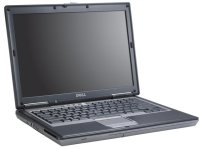 As i wrote before, given my (mis)adventures with IBM/Lenovo I decided to change my allegiances and switch to another brand. So during the research phase I took some time to go to the Dell Expo and get to know their laptops firsthand.
As i wrote before, given my (mis)adventures with IBM/Lenovo I decided to change my allegiances and switch to another brand. So during the research phase I took some time to go to the Dell Expo and get to know their laptops firsthand.
One of the questions I had was about the keyboard: after so many years of working with Thinkpads I have become addicted to the TrackPoint, and I was sure that I had seen photos of Dell laptops with such device, so whatever laptop I decided for really had to have it.
I quickly found out that the laptops in the business line -the Latitudes- are the only models to sport such contraption under the Dell-esque name of “Track Stick”. As a matter of fact, besides the Thinkpads they are the only notebooks *anywhere* that still have it, so either they were found unusable by a significant amount of people or IBM tried to milk its patents just a bit too much. Personally, I believe the Trackpoint is the invention of the century right next to the Twiddler (and lately, even _on_ the Twiddler2) but then again some people believe I am somewhat eccentric when it comes to input devices.
So there I was with the entire Latitude line before me to consider. The D420 is very nice and would make a killer travel notebook, but its specs are somewhat conservative for my needs. And the D820 has a nice screen but is way too heavy. So I settled for the D620. I received it last week and I am documenting how to make it work with Debian GNU/Linux.
So here is my hands-on review of the Dell Latitude D620:
Pros:
Cons:
BTW if anyone from Dell is reading this: please update the configurator for LatinAmerica. You cant’ save your cart. You can’t email it. You can’t even *bookmark* stuff for later perusal. The LA site is primitive, counterintuitive and sometimes even downright annoying. Basically, it got stuck in the 90s.
On the other hand, Dell service was good. Thanks and kudos to both Ivan Castillo -who walked me through Dell’s product line during the Expo- and to Jesus Naranjo -who took my order and was very patient with my obsesive-compulsive hardware demands. One week into it I still haven’t had need to deal with their tech support personnel (Fate has carried on like that for a bit longer) and I hope it stays that way. If they are 50% like their sales people then I have nothing to fear, and altough I have heard some horror stories about them I’m willing to give them the benefit of the doubt for the time being.
In short: Dude, I got a Dell!
[tags]Dell, D620, Review, TrackPoint, Customer Service[/tags]
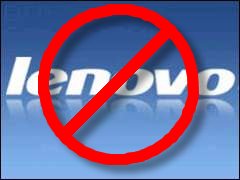 After flickering in-and-out for a few weeks and then getting a misterious red tint, the IBM Thinkpad R50’s display got well for a couple of months before getting all flickery again and dying for good. It was the nicest display you could find in any laptop of its class, even tough it is rather opaque and has its share of glare. I called IBM Tech Support and they told me that I could send it to Guadalajara for service after paying USD$70 for shipping and diagnostics (the backlight’s out, what else is there to diagnose?). I called IBM Guadalajara and was told that I had to pay over USD$100 instead, which I paid up anyway. Then they promptly proceeded to lose my service order for a month, time in which apparently IBM finally managed to kick out Lenovo employees from their Guadalajara offices. After calling their new number repeatedly, I got in touch with them and they finally managed to ship me a prepaid box to send the laptop out.
After flickering in-and-out for a few weeks and then getting a misterious red tint, the IBM Thinkpad R50’s display got well for a couple of months before getting all flickery again and dying for good. It was the nicest display you could find in any laptop of its class, even tough it is rather opaque and has its share of glare. I called IBM Tech Support and they told me that I could send it to Guadalajara for service after paying USD$70 for shipping and diagnostics (the backlight’s out, what else is there to diagnose?). I called IBM Guadalajara and was told that I had to pay over USD$100 instead, which I paid up anyway. Then they promptly proceeded to lose my service order for a month, time in which apparently IBM finally managed to kick out Lenovo employees from their Guadalajara offices. After calling their new number repeatedly, I got in touch with them and they finally managed to ship me a prepaid box to send the laptop out.
Well, as it turns out they have to replace the display. Big surprise! Wanna know how much that’s going to cost? Over US$900, thank you very much. You may be aware that the price of the display is more than enough to buy an entirely new laptop of almost any other brand.
Well, let me tell you about brand loyalty: My first brand-new PC was a IBM PS/2 55SX in the early 90’s. I worked like crazy for an entire summer and the next semester to get my hands on a luggable P70. I even sided on microchannel against EISA during the bus wars. Overall, for over 15 years the IBM Thinkpads had been my favorite notebooks. And I advocated them everywere, because even tough they were *very* expensive, their quality was outstanding.
And up to the 600 line they were excellent. But the L series was terrible, the power brick and the laptop itself overheated a lot and overall had awful power subsystem glitches. Anyway -and against my wife’s warnings- I went and bought this R50 anyway just because bdelgado got me a good deal, but it came with a bad hard disk right out of the factory, has a battery that degraded incredibly fast (half the original lifetime in six months of moderate usage, and nowhere near the advertised lifetime to start with), had to have its motherboard replaced barely a month before the warranty expired and it still overheats and has glitches in the power subsystem.
And to think that I was already looking into getting a Thinkpad X41 right before the R50 crapped out.
So decided that I am not going to spend that much money to replace the display in an outdated laptop. Moreover, I’m not willing to keep pumping money into a company whose QA processes seem to have disappeared, and whose service has got so bad that they lose a service order for an entire month.
So, goodbye IBM. Or Lenovo. Or whatever manufacturer they sell out to next. And hello Dell. I just bought a Latitude D620 and I’ve started to document my adventures with it. I will keep all of you posted on that.
In the meantime it’s goodbye forever to IBM/Lenovo computers. Thanks for the memories, but I’m not looking back, and it feels really good.
[tags]IBM, Lenovo, Thinkpad R50, Laptop[/tags]
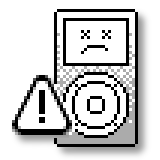 A couple of months ago my (formerly) trusty iPod anounced its impending death and I didn’t listen. Sure, it hung up a couple of times, but it had done that before. When I tried to connect it to a PC to feed it the latest podcasts the PC hung up, but Windows machines do that, too. A lot. Later I copied an ISO image to the laptop under Linux, and it took an unusually long time, but I was tired and didn’t even think of taking a look to dmesg. When I whipped out the iPod to listen to some music during an 11-hour flight only to find out that the battery was dead –even tough I had charged it overnight– I didn’t gave much importance to the issue. I just forgot to toggle the hold switch, I rationalized. So when it definitely locked up with a whirring noise and the clicks that usually announce the death of a hard disk, it came to me as a surprise. I felt a cold sweat down my back as an exclamation point appeared on the screen, inviting me to visit the Apple support website.
A couple of months ago my (formerly) trusty iPod anounced its impending death and I didn’t listen. Sure, it hung up a couple of times, but it had done that before. When I tried to connect it to a PC to feed it the latest podcasts the PC hung up, but Windows machines do that, too. A lot. Later I copied an ISO image to the laptop under Linux, and it took an unusually long time, but I was tired and didn’t even think of taking a look to dmesg. When I whipped out the iPod to listen to some music during an 11-hour flight only to find out that the battery was dead –even tough I had charged it overnight– I didn’t gave much importance to the issue. I just forgot to toggle the hold switch, I rationalized. So when it definitely locked up with a whirring noise and the clicks that usually announce the death of a hard disk, it came to me as a surprise. I felt a cold sweat down my back as an exclamation point appeared on the screen, inviting me to visit the Apple support website.
*Then* I remembered that I don’t have a backup of my iPod.
Of course, my iPod has a copy of my entire music collection. Heck, the iPod *is* my entire music collection, since it has every track of every CD I have ever bought, including many that have been lost or stolen. On top of that, it has more that 5GB of podcasts, a few ISOs, an essential software collection and an encrypted volume with a backup of critical information. The data files didn’t worry me as much as the music, because most of them were just backup files, but recreating that volume was going to be bothersome at best.
Now about the music… I have spent countless hours tagging, classifying and pasting artwork and lyrics to my music. That really hurt.
The iPod got worse really fast. After following the instructions on the Apple website a couple of times to get it into disk mode just to be ignored by the PC in turn, the folder icon was replaced by the dreaded Sad iPod icon. That’s it for the iPod, i tought. I should have bought that 60GB iPod with the color screen when I had the opportunity, instead of waiting for an 80GB model that never materialized.
When I followed the instructions on Apple.com I saw that Apple is more than willing to replace my out-of-warranty 4G iPod –engraving and all– after I dutifully paid US$250. Or I could shell out a few more bucks for a newer model, and forego all the accessories I have bought over the last three years, which have cost a small fortune and none of which will work with a video iPod. Smart move, Steve.
So let’s move on to the other option: perhaps I can replace just the hard drive. *Mmmh…* They go for some USD$100 for a 20GB one, and about USD$130 for the 40GB I need. That’s about half the tribute to Apple for a replacement. So I started looking for other people’s experiences replacing a broken iPod HD, and came across a post detailing William Mitchell’s own encounter with the Sad iPod icon, a reference to Josh Highland’s experience replacing an iPod HD and a cryptic reference to “dropping the iPod” near the end. Josh’s instructions are pretty straightforward, but when I read the comments to his post I found out that apparently many people have had success reviving their iPod by smacking it. Now in my experience one thing is dropping and Apple ][ a few inches to settle the RAM ICs into their sockets, but smacking an iPod to “realign” the HD head is something entirely different. I’m a trained Electronics Engineer. I am a member of the ACM. I *know* that this is not the way things work. But since the HD was dead anyway I decieded to give it a try.
I read the instructions again. No, there was no mention of any blood sacrifice or any other form of dark magic that could compromise my soul any further. I toggled the hold switch exactly ten times. I took the iPod with my left hand, and slapped the right side firmly. I turned the iPod on, and lo and behold: the whirring noise was gone, the clicks wheren’t there, and the iPod worked. My belief system was shaken to its core.
Now I can attest to the miracle.
I connected the iPod to a PC immediately and it was recognized. I spent a couple of hours looking for a program that could backup a selection of the songs in the iPod — podUtil is nice but won’t work in advanced mode unless you register, and in basic mode a nag screen pops up every 50 songs or so. ephPod is still broken, and YamiPod is great but Smart Playlists don’t work. Everyone else want to set you back at least US$19 for the privilege of backing up /your/ music from /your/ iPod to /your/ computer — a feature that iTunes should have in the first place. What the heck. I just plugged it into a Linux box and rsync’ed the entire partition –including the entire iPod_Control– to the storage server. It complained with I/O errors in a couple of files, which were promptly dd’ed with zeroes just in case the HD controller is able to reallocate those bad sectors. I entered the diagnostics mode and ran a HDD scan which the iPod passed with flying colors. And it is still working and merrily pumping out music as I write this.
The lessons I learned: Smacking stuff to make it work applies to high-tech gear as well, unbelievable as it may seem. Apple needs to provide an easy, intutive way to back up your music or move it between your iPods without resorting to third-party utilities. Throwing out backwards compatibility for consumer electronics is a smart financial move for Apple and its licensees, but it doesn’t make any sense for the consumers themselves. And finally the iPod is no walkman — you still have to back it up periodically. I should have known better.
So it looks that the iPod is fully functional again. I just *know* that the HD will fail again –probably for good this time– so I ordered a replacement HD anyway. But now I have my music and my tags securely backed up, so I won’t care as much when the iPod breaks again during the next worktour.
Update: In an amazing display of synchronicity, I just read Fate’s latest post on this same topic. I swear I had not seen it before, nor discussed this specific remedy with him (Actually, I still owe him a cup of coffee)… Perhaps there are no coincidences after all?
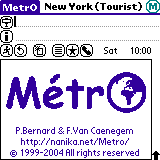 (*ack!* WordPress ate my post!)
(*ack!* WordPress ate my post!)
Live in Mexico? Have a TiVo? Read the TiVo-in-Mexico HOWTO to transform that glorified VCR into a real Personal Video Recorder.
Update 20051009: I just bought a TiVo 2 unit and it’s on its way, so I’ll update the HOWTO within a few weeks.
Note: This post was originally listed under the static TiVO page, but I’ll start managing the TiVo section with WordPress.
To change your TiVo’s timezone and date/time follow these steps:
# ./timezoneadj30.tcl
# settime 20031123025900 # settime -rtc
# reboot
Note: This post was originally listed under the static TiVO page, but I’ll start managing the TiVo section with WordPress.
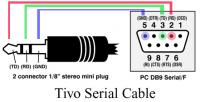 I found this excellent diagram for a TiVo serial cable:
I found this excellent diagram for a TiVo serial cable:
TiVo serial cable schematic.
The original URL is http://www.tivohelp.com/archive/tivohelp.swiki.net/.uploads/serial/tivocable.jpg
Note: This post was originally listed under the static TiVO page, but I’ll start managing the TiVo section with WordPress.
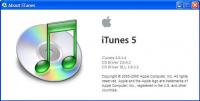 I recently upgraded iTunes to 5.0 on Magda’s laptop and it decided to start speaking to me in Spanish. In my Thinkpad with Windows XP in english iTunes was still in english.
I recently upgraded iTunes to 5.0 on Magda’s laptop and it decided to start speaking to me in Spanish. In my Thinkpad with Windows XP in english iTunes was still in english.
Magda’s laptop came pre-installed with Windows XP in spanish, but I have never had a problem installing an english version of any kind of software in it. So far, every iTunes version had asked for an installation language during setup, and stuck with that language forever. iTunes 5.0 is different: no matter what language you use during setup, it will move on to the system locale whenever you run it. I bet that somebody in Cupertino believes that this is a “feature”, but actually iTunes is ignoring an explicit user setting, a usability do-not that comes as a surprise from the UI gurus at Apple.
Just to state a fact, I’m no Malinche. I write and speak an above-average Spanish, and I do love my country and its language. But I like my english software in English, and I do not have to endure the work of some underpaid english-to-spanish translator that can’t speak either language right nor understand their respective subtleties. Besides that, the iTunes ES translation is not for Spanish but rather for Castellano, and some strings are somewhat annoying. “Party Shuffle” sounds nice. It has a festive tone to it. When iTunes is in Party Shuffle mode my subconscious thinks I’m at a party, even if it’s 2am in the morning with two deadlines to meet early in the day and a senior programmer on vacation. In comparison “Sesión aleatoria” -random session- sounds just plain boring.
Today I upgraded to 5.0.1.4 half expecting this bug to be gone, but surprisingly it is alive and well and sends best wishes to everyone back home.
A quick google search got back an interesting result on Playlist Magazine’s forums: just close iTunes, go to its installation directory under “Program Files”, find every directory named <offending language code>.lproj (for me that was es.lproj) under iTunes.Resources, iTunesHelper.Resources and iTunesMiniPlayer.Resources and nuke them out of existence. The one under iTunesHelper.Resources might complain about a DLL being in use. Just move that DLL to some other place and delete it after a reboot. The next time you run iTunes it will talk to you in English.
Last night I got to play with ibm-acpi for a little while. It was refreshing to watch the backlight on the R50 go to sleep after being continually on while running on linux, thanks to radeontool and ibm-acpi’s magic to intercept Fn-F3. Priyadi Iman notes that ibm-acpi is included in kernel 2.6.10, but I’m still running the Ol’Thinkpad on 2.6.9, so I will have to play around with a newer kernel and report back my findings.